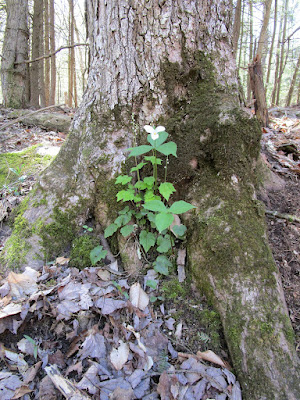In the background of this photo between the trunk vees, some bare ground can be seen. Weeding that area was my focus this morning. In the foreground close to a fern, a new fawn is visible. Apparently the fawn was there the entire time that I was working. I moved intending to weed in the right foreground. That was when I discovered the fawn and left the area to get Becky.
Several years ago I came upon a new fawn in the path to the back. I advanced slowly to try for a closer look. The fawn jumped to its feet trying to move away. Its legs shot out to the sides and I left the area. The next day the remains of a coyote fawn feast littered the ground. I felt responsible for this death. We kept our distance this morning using the zoom feature on the camera to snap the picture. Our distance away was acceptable as the fawn was still curled up next to my garden fern several hours later. I view this garden ground as mine but apparently the deer also claim ownership. I could not disturb the new baby.
We saw the fawn in exactly that same spot several times during the day. An internet search revealed that it is normal for the newly born deer to be placed in hiding all alone for upwards of twelve hours. We found it somewhat troubling that this new baby was without food, water or company. In the early evening from the comfort of our sofa we saw the mother deer and her new baby briskly walking across our lawn. Mother was setting a fairly quick pace with junior working hard to keep up but seemingly enjoying the action. All was right with this new life despite its being placed in our much fussed over native plant garden.
We used the car to get Becky down the hill to see the fawn. Believing that short trips are harmful to the vehicle, we drove across the valley to Irma's woods. This native violet is a family favorite.
Despite the pure white appearance of the front of each flower, the back side of each blossom is purple. Identification of a flower is easy. Exactly what Viola it might be is more difficult.
Viola rugulosa looks very possible to me. These violets appear here in huge numbers and removing a couple would do no harm. Remembering the former owner of this land, we did not dig anything.
American sarsaparilla grows wildly here. The bud covered spheres promise a generous display of flowers. Several of these plants are growing in the gravel that edges the road. It seems only prudent to rescue these plants that recently survived a brush with the snow plow. We had no tools with us so no digging was done. We repeat this conversation with ourselves every year but no digging here is ever done.
These Marsh marigolds were purchased last year. We let someone else remove these plants from the wild. This ground is close to the base of our bedrock ridge. All of this low ground is presently filled with bands of water although none can be found at the far end of the field. Apparently, the water here is sufficient to support generous growth for these plants. Wet spots are common here especially after the recent heavy rainfall and it was no easy task to keep feet dry while approaching these flowers.











mnp.jpg)























mnp.jpg)

mnp.jpg)
